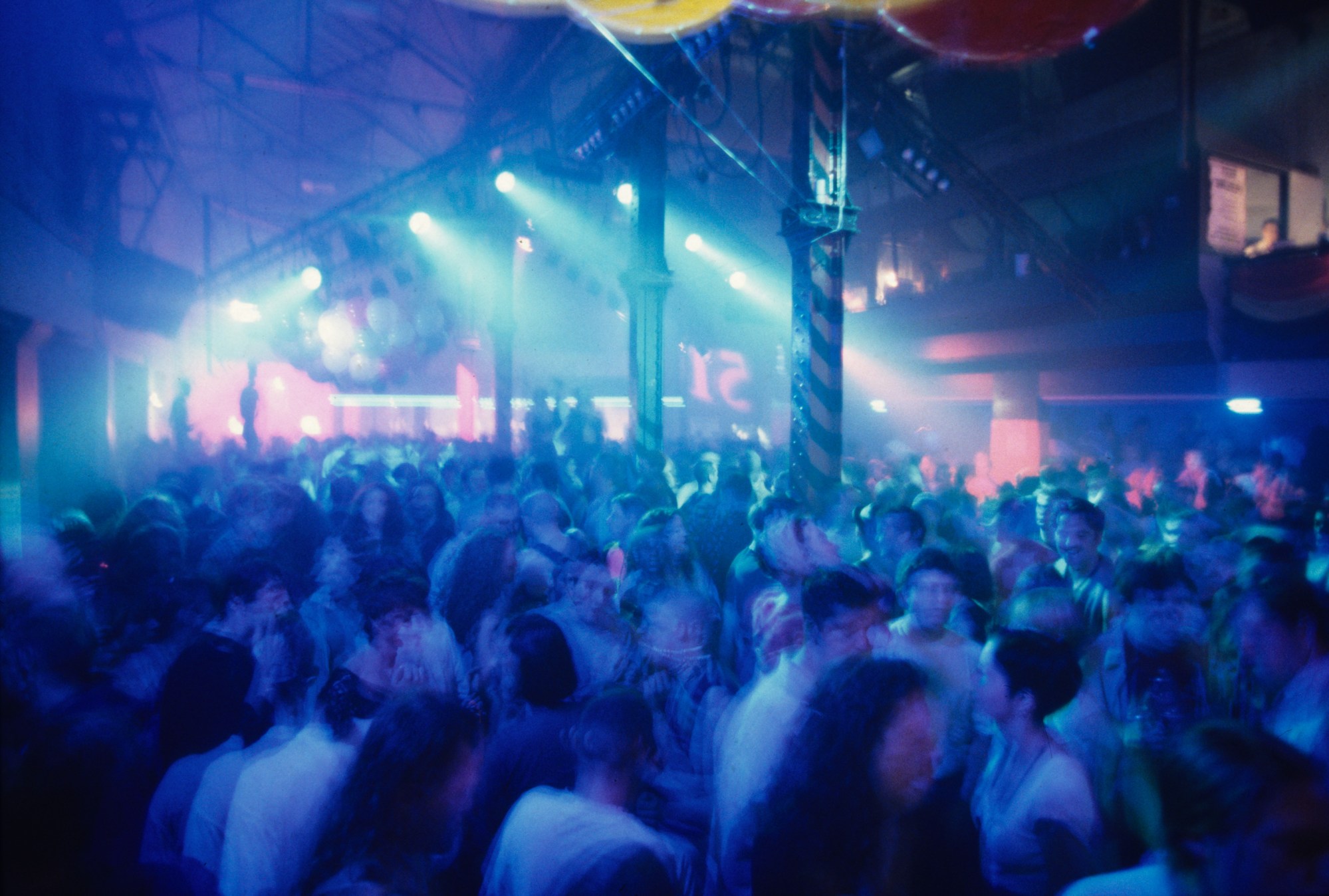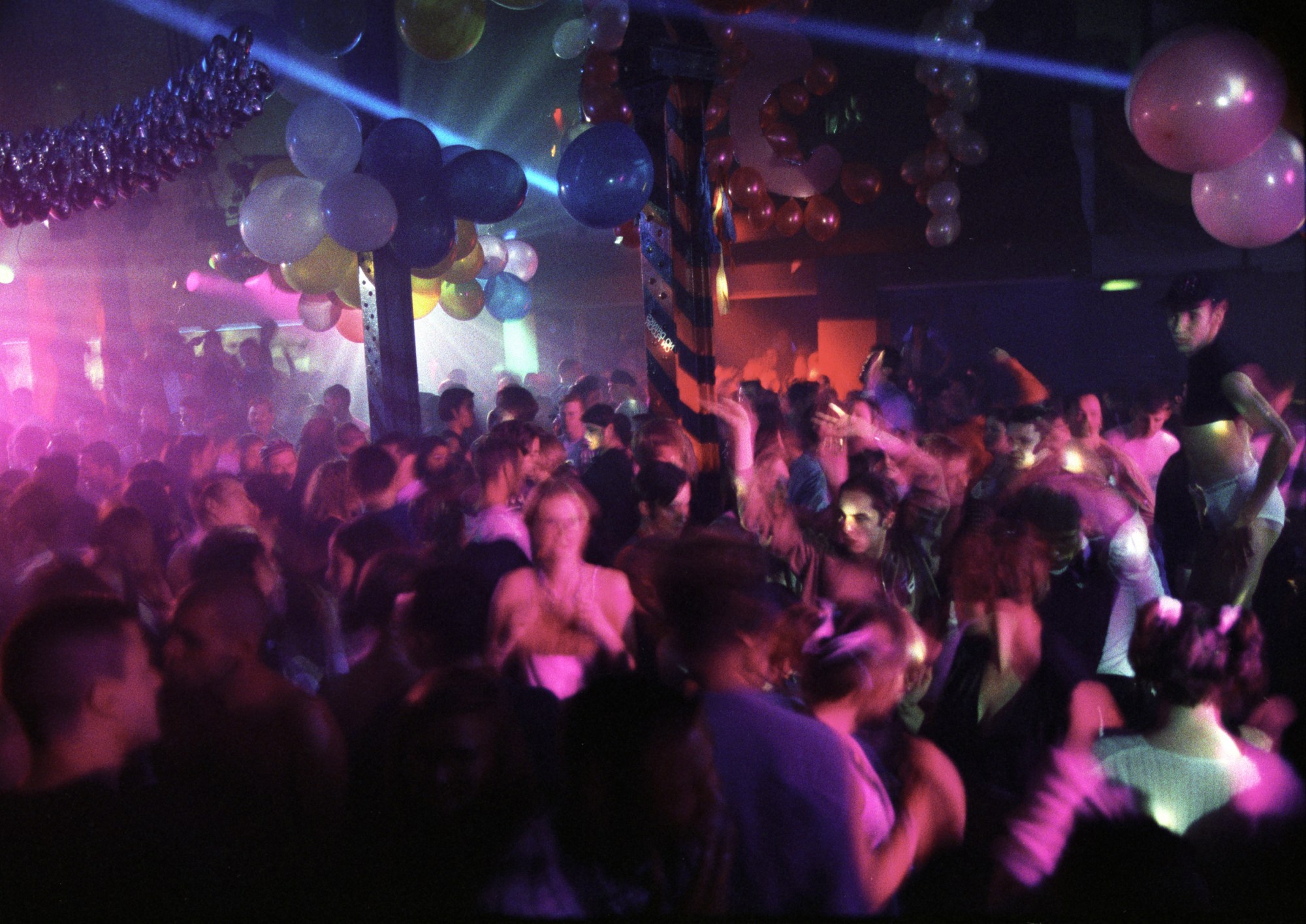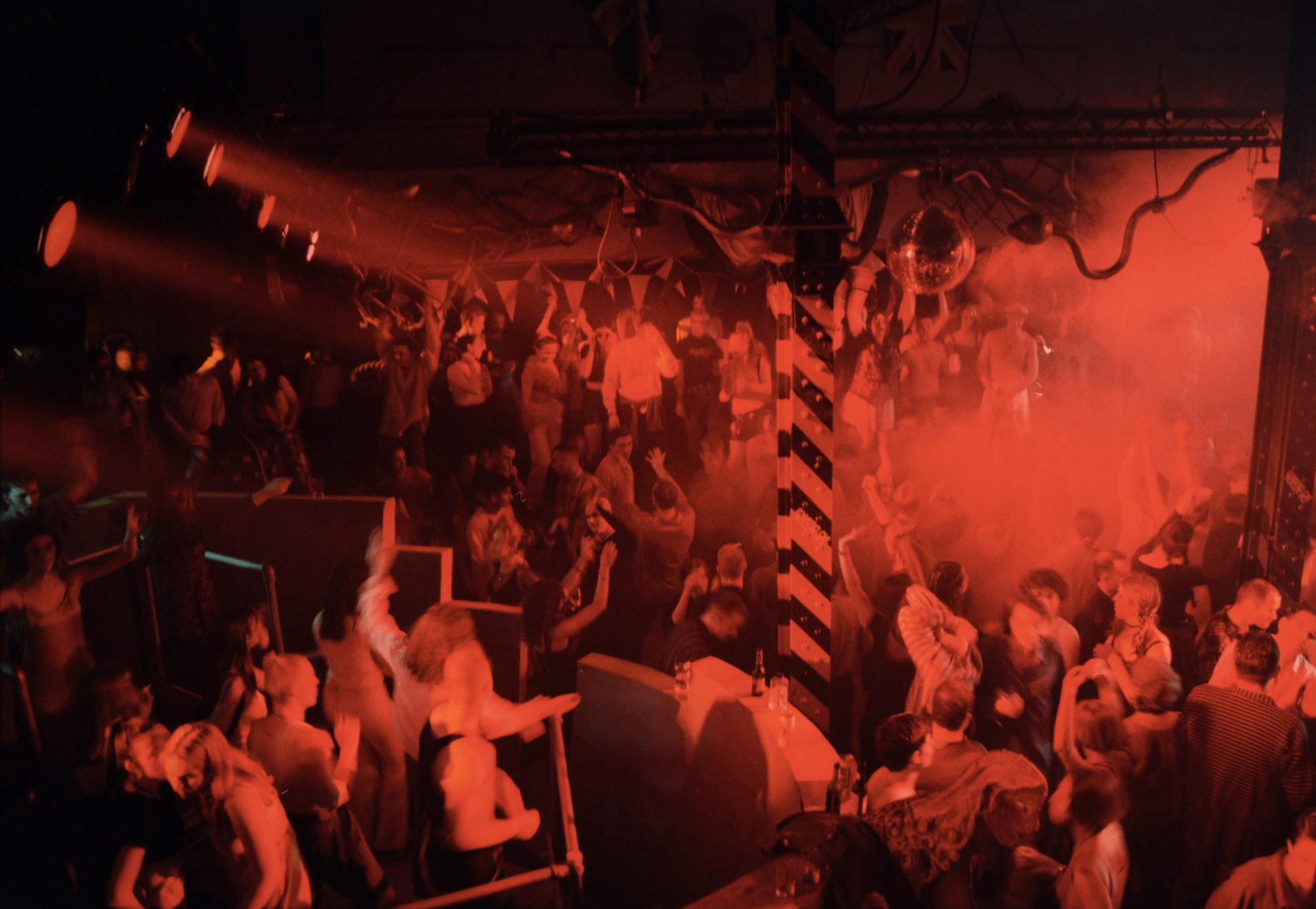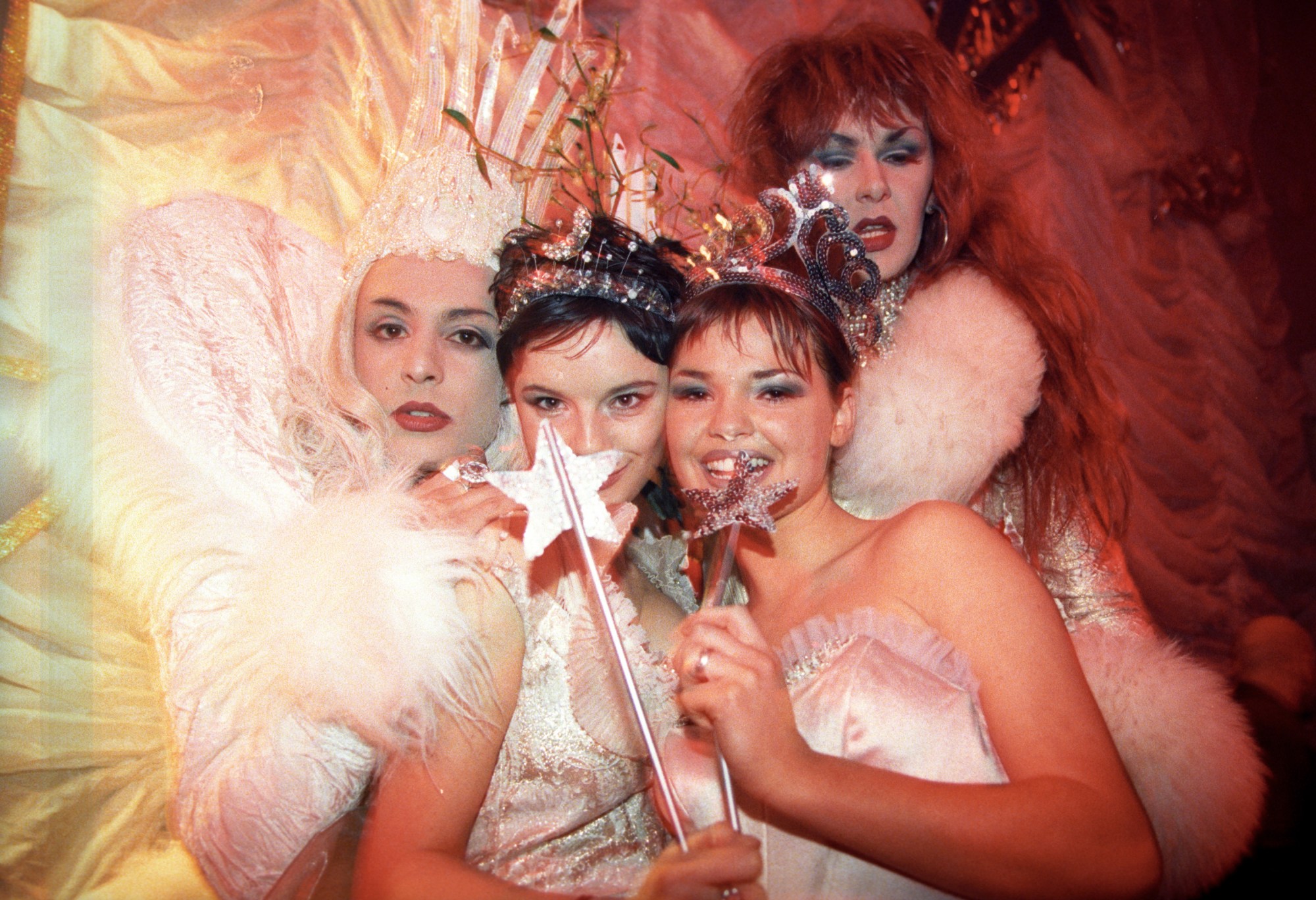I’m in photographer Jon Shard’s spacious studio in Manchester’s Ardwick, looking through his pictures from the city’s best-known club, the Haçienda, which opened in 1982. Situated in a former yacht showroom, it was a vast warehouse which ushered in a new era in music — acid house, and where Jon cut his teeth as a music photographer in the early 90s.
It’s been over twenty years since then, but Jon remembers one night vividly. The music cut out and the lights came on — no one was allowed out. An announcement was made from the DJ booth: a number of bouncers had been stabbed. By the time Jon emerged from the club hours later, there was a row of riot police outside, a helicopter with a big searchlight hovering overhead and a news crew.
But we’re not here to talk about the Haçienda’s demise and eventual closure in 1997 — that’s been well documented. It does however need to be mentioned, because it was within this context that Jon discovered Flesh — the Haçienda’s politically charged monthly gay night. A mid-week celebration of sexual emancipation, Flesh was the club’s most profitable event as the Haçienda struggled financially in the mid 90s, and where DJs Kath McDermott and Paulette became the club’s first female residents.
The reason Jon didn’t experience the club’s 80s musical heyday — when DJs like Mike Pickering, Graeme Park and Sasha made their names there, is a simple one: he wasn’t old enough. He was still at school in Stockport, studying for his GCSEs. But when he did finally get into the club which built on the success of Factory Records — best known for releasing music by Joy Division, New Order, and the Happy Mondays — he quickly became one of the world famous venue’s most prolific photographers.

Sweet Harmony, an exhibition that celebrates acid house and rave culture, first shown at London’s Saatchi Gallery earlier this year, is moving to Manchester’s Depot, a vast warehouse space currently home to The Warehouse Project.
Jon Shard is among those who’ve been chosen for this version of the exhibition. He’s not really had time to look through these iconic photos in recent years, but as he says, “it’s nice to see some enthusiasm from other people; it’s nice for my work to be celebrated.”
How did you go from being a punter to taking photos at the Haçienda?
I was just leaving college doing photography, and I was trying to find a way into photographing for magazines — I wanted to get into the music scene — so through a few friends that I knew I managed to get into the Haçienda with my camera, and I used to just take pictures purely for myself. But then with those pictures I built up a portfolio and I got into magazines like Mixmag and so on.
What was the atmosphere like at the Haçienda and what were you looking for when taking photos there?
I was trying to show the scale of the club, because for me, the first time I went in, you could hear the music pounding from outside. They had fiberglass windows and when you were queuing you could hear this thud — it was like a low bass, it was just amazing. And when you walked through, it was almost like walking into a cathedral of music. You’d go through the little pay booth, and it opened up into this warehouse of light and sound. There was a lot of energy there, everyone was just really into the music. I think the drugs helped with it as well, which was a big part of the scene. But the lighting — I was always interested in the lighting — it wasn’t like your normal club, being in a warehouse, it felt special.
How did Flesh differ from the other nights?
Well it was a gay night, so it was predominantly gay people with straight friends, and it was certainly a very different crowd from the Friday and Saturday nights, because at that time, ’93-’94, it was starting to get a bit rough at the club. But you wouldn’t get a lot of them guys who were causing trouble going to a gay night because they didn’t want to be associated with it, so, in turn, Flesh became the coolest night ever, it was the place to go to.

You’re often referred to as Flesh’s official photographer. How did that come about?
That’s not quite true. I wasn’t the only photographer there but I took the most pictures. I was there for every single one, and the main reason being that it was probably the best night to shoot, because of the carnival atmosphere. And for me, to be honest, as much as I loved going, I was also a bit of a workaholic, so it was important for me to get decent shots, not only for me, but whoever I was working for, and at Flesh, I always could.
How did you approach photographing that night?
I’d just shoot a lot more, because there was more to photograph. It was a lot more flamboyant, it was more colourful, everyone would spend two-three days working out what they were going to wear for it. Because I was friends with [Flesh promoter] Paul Cons, I’d know exactly what was going on on the night, so, I kind of just took a lot of film, knowing that I would get some great images.
Some of the shots are almost like paintings.
I would always get the standard shots of people – but I wanted to be more creative than that and show it in a more abstract way too, with the movements and the colour all sort of combining, so it’s like a sea of bodies dancing in the club.
The other thing as well, on a technical side of things, a lot of clubs, a lot of club photography, is just a heavy flash and just that person – it could be in any club – whereas at the Haçienda, because it was so vast and big, I would always try and capture it when the lights were all on at one particular point, and do a slightly longer exposure. It would be very dark and then all of a sudden you’d get this explosion of light coming through and it just looked amazing if you were able to capture it. It was almost like a spaceship had descended and lit up the whole club.
I preferred to take the pictures from a distance, almost like a football crowd, rather than going too close all the time, for me it makes the club look a lot more dramatic. Then after, you could spend hours just looking at every individual face and what they’re doing.

What’s your favourite photo?
Probably the blue shot, which is a shot of the crowd. Whenever I think of that club and the light, I always think of that particular blue.
What’s the most shocking thing that you remember?
On the Flesh nights there were people walking around with nothing on. You’d be stood in the bar and there’d be a guy there with his bum out.
Flesh has arguably been forgotten by the history books. Did it feel special at the time?
It did because a lot of the people, the friends around me, would be talking about it all month. And people came from London, people came from Scotland, you even had people from Europe coming over, and it was always packed, it was always full. It’s crazy in retrospect — a night which was on a Wednesday, imagine coming over from Europe for a night out on a Wednesday! So it would be nice to see Flesh talked about a bit more, because it was one of the most important nights there — it was probably the biggest gay night in Europe.
What was your relationship like with the Haçienda owners?
The hardest thing was trying to get money out of them! They’d always ask me to go on the Monday when they still had the cash from Saturday night. And they used to always pay me in £5 notes and I always remember it looked like I was really rich. They didn’t pay me a great deal, but you know, if I had a couple of hundred pound’s worth of £5 notes in my wallet, it looked as if I had a good day.

As the club fell into decline and suffered financially, did it become harder to get work?
It became very awkward actually. I remember one night when it started declining, the doormen were very difficult. I actually had an exhibition one night at Flesh in the Gay Traitor, which was at the bottom of the Haçienda — it was a separate little bar. I remember going through before the night had started and the doormen were stopping and searching me even though they knew I had an exhibition on there and they just, it just turned a bit nasty. I saw a different side to it then, the doormen seemed to be controlling a lot, letting their own dealers in.
How many pictures do you think you took there over the years?
It’s hard to say because I don’t have a lot of the images, but quite a lot. At the time I would shoot on slide film and I would send them to the magazines and a lot of the time I wouldn’t get them back, so there’s probably thousands of images out there that I’d like back but that have probably been lost now.
Has your relationship to the images you have changed as time has gone on?
I looked through them recently and it’s amazing how fast time’s gone by. It’s over 20 years ago, it’s quite scary really, but I look back on it with good memories, it was all new to me then.
What do you think young people discovering rave culture for the first time can learn from this exhibition?
All I thought about when I was shooting was just capturing the scene at the time, because I knew it was something special, what with everything that was going on with the music and atmosphere, the people and how they were. I knew it was something historic and that’s why I liked to photograph it. I did think, with all the other clubs I’d been to — and I’d been to quite a few in New York, and they were great — but the Haçienda had something the other clubs didn’t. So hopefully it shows that it really wasn’t like anywhere else in the world.
Sweet Harmony is open until Wednesday 11 Dec at Depot, Manchester.
